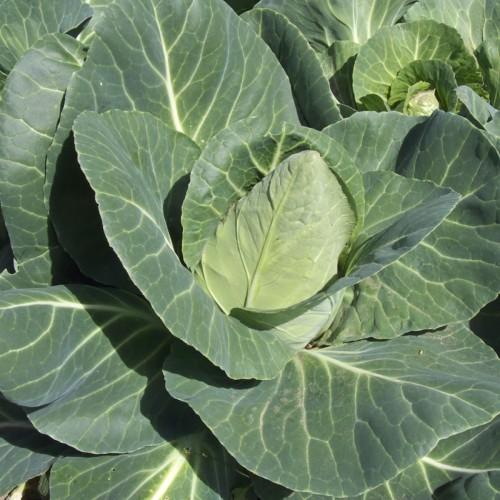
cabbage
Brassica oleracea (Capitata Group) 'Frigga'
Cycle:
Annual
Watering:
Average
Hardiness Zone:
2 - 11
Flowers:
Flowers
Sun:
full sun
Fruits:
Fruits Ready In
Leaf:
Yes
Growth Rate:
Low
Maintenance:
Low
Salt Tolerant:
Yes
watering
Cabbage requires consistent and uniform watering for best growth. Water your cabbage 1 -2 inches deep once per week. During hot and dry weather, have an extra watering - 2-3 inches of water once every 3-4 days. Soak the soil deeply and slowly; avoid runoff. When cabbage is over-watered, its heads may split. Water in the morning to avoid wet leaves at night, when they’re more likely to develop disease.
sunlight
Cabbage (Brassica oleracea (Capitata Group) 'Frigga') should receive 4 to 8 hours of direct sunlight per day while it is in the growing stage. When it is ready to be harvested, the amount of sunlight can be reduced to 2 hours per day. Providing direct sunlight for more than 8 hours could lead to sunburned or wilted leaves. Inadequate sunlight results in poor quality or small cabbage heads. For best growing results, ensure your cabbage is in a sunny location and avoid shady areas.
pruning
Cabbage can be pruned as soon as it reaches 10-12 inches tall, shaping the plant to promote bushy growth. As the plant develops, the outermost leaves may turn yellow and become tough. These leaves should be pruned to keep the plant from becoming top-heavy or to maintain an attractive shape. Pruning cabbage should be done regularly throughout the season as the plant grows. Generally speaking, you will want to prune once a month or more during the growing season. Pruning should also be done after every harvest of the inner heads of cabbage. The remaining outer leaves should be pruned to 5-6 inches back from the main stem, which will encourage the plant to produce new leaf growth. Pruning promotes healthy plants with strong roots and vibrant foliage.
Season
Hardiness Map
FAQ
Are Brussels sprouts a type of cabbage?
Yes, Brussels sprouts are a type of cabbage. They are thought to have originated in the area around Brussels, Belgium, which is how they got their name. They are a small, cabbage-like vegetable, usually about the size of a quarter, and have an outer layer that ranges in color from green to reddish-purple. They are nutritionally packed, containing a variety of vitamins, minerals, and antioxidants.
Are Brussels sprouts grown above the ground?
Yes, Brussels sprouts are grown above the ground. The vegetable is actually a member of the cabbage family and is a small, round vegetable that looks similar to a miniature head of cabbage. Brussels sprouts are typically grown in much the same way that other head crops like cabbage or broccoli are grown with the plants maturing into a stalk with the small sprouts forming all around the stalk from the bottom up. The sprouts can then be harvested with the stalk.
Do Brussels sprouts contain vitamin C?
Yes, Brussels sprouts do contain vitamin C. In fact, they are a good source of this essential nutrient. One cup of cooked Brussels sprouts contains about 48 mg of vitamin C, which contributes to 55% of your daily value. Vitamin C is a powerful antioxidant and is important for the growth and repair of tissues in the body, as well as for wound healing.
Is it safe to eat Brussels sprouts raw?
While eating Brussels sprouts raw is considered to be safe, it is generally not recommended. Raw Brussels sprouts can be tough and difficult to digest, and may be bitter in flavor. If you choose to eat them raw, make sure they’re fresh and thoroughly washed to avoid the risk of foodborne illness. For a healthier and tastier option, try lightly steaming or roasting your raw Brussels sprouts. This will help to reduce any bitterness while helping to make them more digestible.
Is Brussels sprouts low in calorie vegetable?
Yes, Brussels sprouts are a very low in calorie vegetable. One cup of cooked Brussels sprouts only contains 56 calories. They are also very low in fat and cholesterol, making them a healthy part of any meal. In addition to their low calorie content, Brussels sprouts contain important nutrients like vitamins A, C, K, B vitamins, minerals, fiber, and antioxidants. They can be eaten raw, cooked, or roasted, so you can find a way to make them a delicious part of any meal.
Do Brussels sprouts have different varieties?
Yes, Brussels sprouts do have different varieties. Common varieties of Brussels sprouts include long island, jade cross, and conehead. Long island sprouts have large, yellow-tinged leaves and a nearly uniform, globe shape. Jade cross is a newer variety which produces vigorous plants with large, dark green sprouts. Conehead is another popular variety as it tends to produce sprouts with a tip that tapers into a cone rather than a tight ball. All varieties of Brussels sprouts are known for their nutty flavor and crisp texture.
